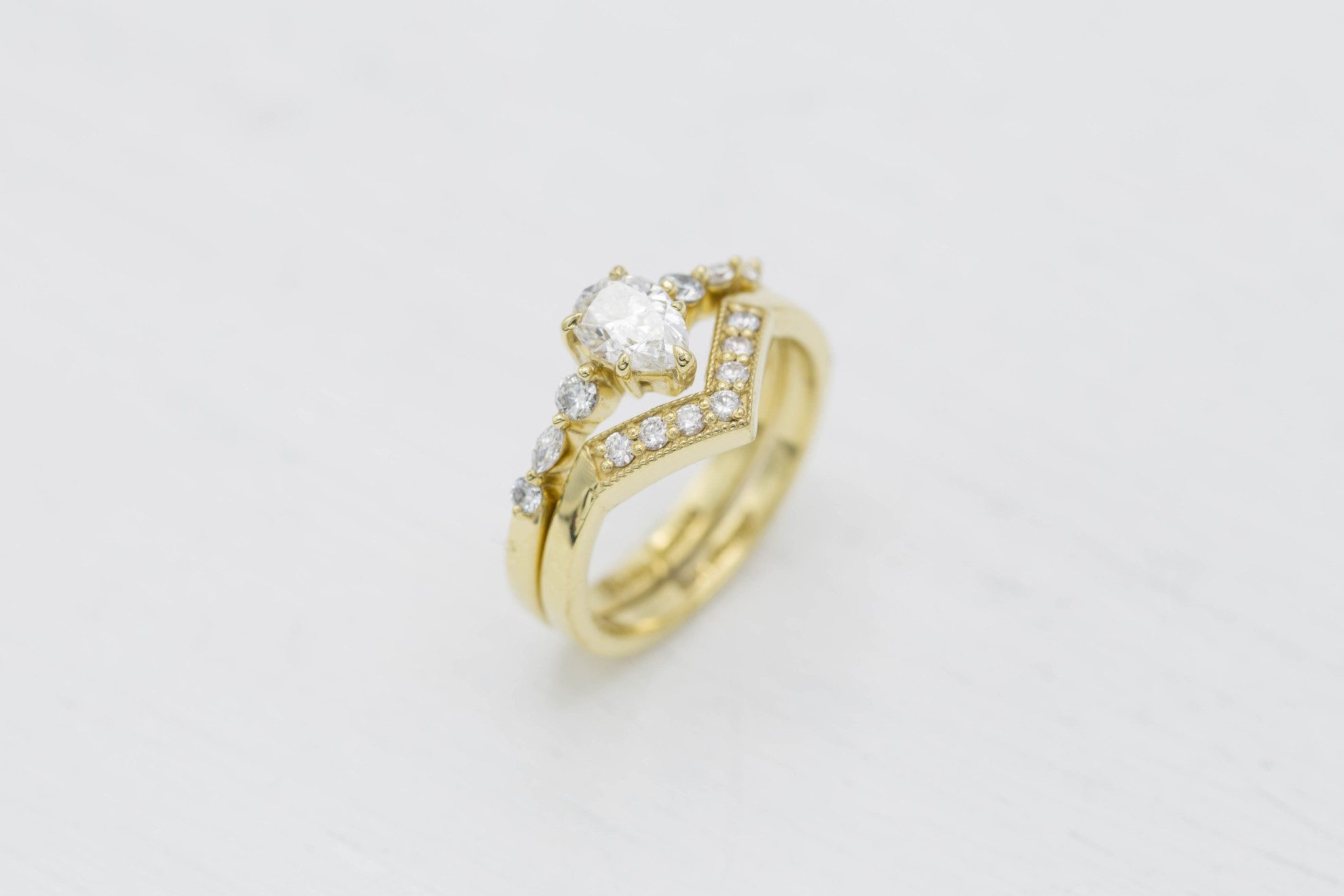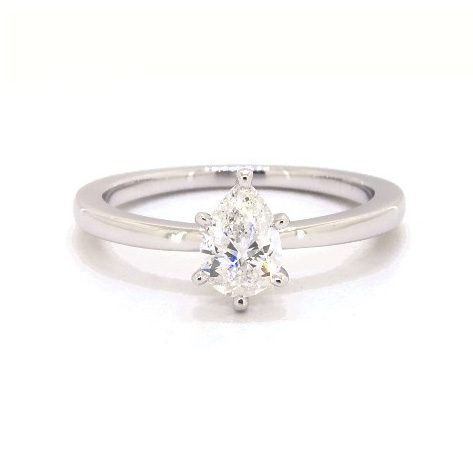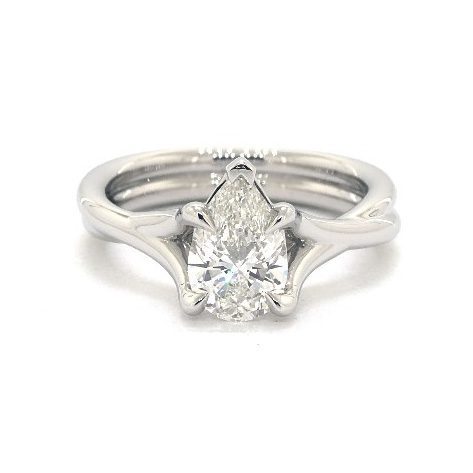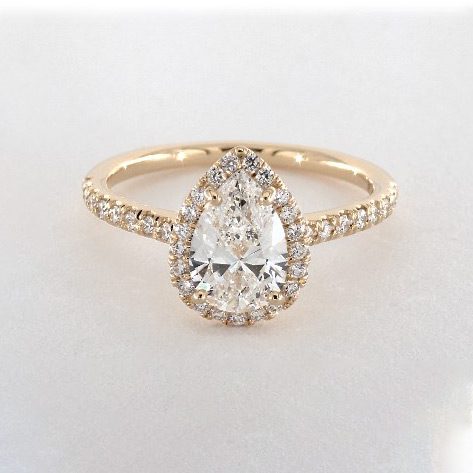Pear Shape Diamond Guide: Unique & Stunning
Dreaming of a pear shaped diamond engagement ring? Learn the pros and cons and read our expert advice to find the perfect pear for your style and budget!
11 Minute Read
Learn the pros and cons of pear shaped diamonds and how to find a beautiful, sparkling natural, or lab created diamond for your engagement ring.
at CustomMade
Pros and Cons of a Pear Shape Diamond Engagement Ring
If you're considering a pear shape diamond for your engagement ring, it's always a good idea to look at the pros and cons. Ultimately, you should buy the diamond shape that you like best.
Pros: Size, Cost, and Style
Other than an eye-catching shape, pear shaped diamonds have some great advantages over traditional round-cut diamonds. Because of their elongated shape, pear cuts look larger than a round diamond. But it's not just appearance, they're actually 8% larger on their top surface!
This means that even a small diamond will make a big impact. Of course, a large pear will look absolutely huge.
Better yet, pear-shaped diamonds can cost 10-30% less than a round diamond with the same carat weight.
In addition, pear shapes have a versatile style, great for vintage, modern, and classic looks. Celebrity engagement rings like Ariana Grande's have also made pear shape diamonds trendy.
at CustomMade
These diamonds can be worn tip up or tip down, though most choose to wear the point toward the fingernail. They're also great for unique east-west settings.
Cons: Fragile Tip, Rarely Well-Cut
Still, pear-shaped diamonds have some disadvantages, too. The tip of the diamond can be fragile and prone to chipping. When properly set, prongs should prevent any damage.
Most pear shape diamonds are set with 5 or 6 prongs, with a v shape prong to protect the pointed end from damage. A setting with more prongs will make the gem more secure in the ring, but will also reduce the visibility of the gem. A setting with fewer prongs will show off the gem but may increase your risk of losing or damaging the gem. Halo settings are also quite popular with pear shaped diamonds, as the ring of small diamonds can highlight the gem's exceptional pear shape.
In addition, finding a well-cut pear-shaped diamond can be difficult. Since gemological laboratories don't assign cut quality grades for fancy-shaped diamonds like pears, you'll have to carefully examine the sparkle and shape to find a well-cut stone.
Pear Shape Diamond Cut Quality
Judging cut quality in a pear shaped diamond is far different from judging a round diamond. For pear cuts, both performance and shape are essential. You'll have to know what to look for.
You can start by limiting the depth to 56-66% and the table to 55-66%. Beyond that, the diamond's grade report won't tell you anything about its cut quality.
Symmetry is Essential
Look for symmetry in the shape. If you draw an imaginary line from the diamond's point down the middle, the sides should be symmetrical.
If it looks off but you can't tell why, just pass on it. It's probably asymmetrical or off-shape, even if you can't put your finger on it.
Note that this symmetry differs from that of symmetry grades, which tell you how well the facets align. A symmetry grade of "good" or better will suffice.
Judging Symmetry from Online Video
Online videos are great for judging diamond quality. However, the unique shape of the pear poses some challenges.
In online videos, pear-shaped diamonds are shown on their side, at an angle to the viewer. This can make them appear asymmetrical when they're actually well-cut.
You'll need to drag the camera to determine whether the pear has good symmetry and shape. Try to get both shoulders (sides of the semicircle) the same distance from you. Then, do the same with the wings (sides near the tip). If it still looks off, pick a different diamond.
Finding the Perfect Length-to-Width Ratio
The length-to-width ratio (L/W) in a pear-shaped diamond is largely a matter of personal preference. However, most people prefer a ratio of 1.45 to 1.75. Compare these diamonds and see what you like best.
Always look at the actual dimensions of the diamond and consider how large it will be on the finger. Longer diamonds appear larger and have more of a slimming effect on the finger. However, some prefer a broader diamond.
For smaller diamonds, you may want to stick to ratios of 1.60 to 1.75. The prongs on certain settings can make pear shapes appear more triangular.
at James Allen
Shape Appeal
It's also important to look at the actual shape of the diamond. If the shape isn't right, choose a different one.
A pear shaped diamond should have one semicircular end, evenly rounded shoulders, gently curved wings, and come to a point at the other end.
Avoid pear shaped diamonds with a flat end where there should be a semicircle. The shoulders and wings shouldn't be bulging or flat. Bulging areas don't just look unattractive, they also hide weight. That means you'll be paying for a weight that you can't appreciate. Take a look at these examples.
Bowtie Effect
Like oval-cut and marquise-cut diamonds, pear shaped diamonds have a bowtie effect. Since it's an effect of the cut pattern, this is present in all pear cuts.
However, some bowties are less noticeable than others. Avoid large, dark bowties, and make sure this area of the diamond gives some sparkle. If this region doesn't sparkle, the diamond isn't worth your money.
Take a look at the videos for these three diamonds: one with an obvious and unattractive bowtie, another with a noticeable but acceptable bowtie, and the last with a beautiful bowtie region.
Pear shape summary…
- The surface area of a pear shape is a great way to get a diamond that looks bigger but costs less
- Be sure your diamond is properly set to avoid chipping the fragile tip
- A symmetrical cut is essential for this shape or it will look "off"
Pear Shape Diamond Clarity
Like other brilliant-cut diamonds, a well-cut pear shaped diamond will hide clarity imperfections. An SI1 or SI2 clarity diamond will likely be eye-clean, meaning that you won't spot inclusions with the naked eye. If your budget is tight, you may be able to find an I1 diamond that's eye-clean.
For diamonds with these low clarity grades, avoid large imperfections near the center of the diamond. Keep in mind that black inclusions are more noticeable than white ones. If you're not sure if the diamond is eye-clean, try zooming out. If you can't see the imperfections when the diamond is smaller, you won't see them when it's on the finger.
However, if you're opting for a 2+ carat diamond, inching up the clarity scale is a good idea. Since clarity grades are calculated relative to the diamond's size, you should try for a VS1 or VS2 clarity stone.
Unlike our advice for round diamonds, we don't recommend that you limit yourself to the lowest eye-clean clarity grade. Since there are fewer pears to choose from, including higher grades in your search will help you find a diamond with great shape appeal and excellent performance.
Pear Shape Diamond Color
Pear shaped diamonds don't hide color as well as rounds. Color tends to show most in the tip of the diamond, so be sure to look at this area if you're considering diamonds with a low color grade.
For white gold and platinum solitaire engagement rings, an H color diamond will give you the most for your money.
at James Allen
If you've chosen rose gold or yellow gold, a J color diamond will still look white.
at James Allen
For halo and side-stone settings, it's best to match the diamond color to the stones around it. Generally, a G or H color diamond will look beautiful.
at James Allen
If you're opting for a large (2+) carat diamond, keep your minimum color one grade higher than these recommendations. Larger diamonds tend to show more color than smaller ones.
Still, it's best not to limit yourself to the lowest color grade. You may need more options to find a diamond with great shape and excellent performance.
Pear Shaped Lab Grown Diamonds
Should I Buy a Pear Shaped Lab Grown Diamond?
If you are considering purchasing a pear shaped lab grown diamond, there are several compelling reasons to do so.
Firstly, lab-grown diamonds are environmentally friendly as they are created through sustainable and ethical processes, minimizing the impact on natural resources. Secondly, they offer exceptional value for money, typically priced lower than their mined counterparts without compromising on quality. Take a look at each of the pear shaped diamonds below to see the astounding price difference for yourself.
Lab grown diamonds exhibit the same brilliance, clarity, and hardness as natural diamonds, ensuring a dazzling and durable gemstone for your engagement ring. The pear shape, known for its elegant and timeless appearance makes it a stunning choice for engagement rings. With these benefits in mind, investing in a pear shaped lab grown diamond seems like an appealing and responsible choice for both your style, budget and conscience.
at James Allen
at James Allen
How to Buy a Pear Shaped Lab Grown Diamond
When embarking on the journey to buy a pear shaped lab grown diamond, a few steps can help you make an informed decision.
Begin by defining your budget and preferences, considering factors such as carat size, color, clarity, and cut. Next, conduct thorough research to identify reputable and reliable sellers of lab-grown diamonds. Reading customer reviews and testimonials can provide valuable insights into their products and services.
It's also advised to request certificates from recognized gemological laboratories to verify the diamond's authenticity and quality. Whether shopping online or in person, take advantage of viewing multiple diamonds to compare their brilliance and appearance. Here are two identical pear shaped diamonds for you to compare from James Allen and Blue Nile.
at James Allen
at Blue Nile
Ultimately, with careful consideration, you can confidently choose a pear shaped lab grown diamond that not only suits your preferences but also aligns with your budget as well as your values of sustainability and ethical sourcing.
Pear Shaped Fancy Colored Diamonds
Departing from the traditional white diamond, natural colored diamonds open up a whole new world of unique and beautiful jewelry. These rare gems can be found on many popular online jewelers like James Allen and Blue Nile and they make it easy to incorporate into a piece that stands apart from the rest.
at James Allen
at James Allen
From vivid blues to delicate pinks, each fancy colored diamond tells a story reflecting its unmatched beauty and immediately elevates any ensemble. The pear shape combined with the exquisite colored diamond is a wearable piece of art that will be cherished for generations.
Where Should I Buy a Pear-Shaped Diamond?
If you're buying a pear shaped diamond online, always buy from a reputable dealer and review their return and exchange policies. For this cut, you must review the symmetry, shape, and clarity imperfections and see how the diamond performs. Blue Nile and James Allen both offer high-quality, closeup 360° videos of their diamonds.
In addition, James Allen has diamond experts ready to review your choices with you. They'll help you determine if the stone is eye-clean and whether it has surface-reaching imperfections that can weaken the stone. They also offer an extensive selection of ring designs to choose from. Search James Allen's diamonds based on our recommendations.
Blue Nile does offer one advantage when shopping for a pear-shaped diamond. They allow you to limit your search by the L/W ratio. If you're picky about the shape or looking for a replacement stone, this feature will help you narrow your choices.
For a truly unique pear shaped diamond engagement ring, consider using a custom jeweler such as CustomMade. Their experts will help you find the perfect diamond for your budget and design a ring full of meaning.
FAQ
1. Are pear shaped diamonds more expensive?
Pear shaped diamonds are less expensive than round cut diamonds of the same carat weight, coming in at 10-30% cheaper. This makes pear shaped diamonds a wonderful selection if you are on a tighter budget but still want a diamond that is sure to make a statement.
2. Is pear shaped diamond good?
Pear shaped diamonds are a popular choice for buyers looking for a truly unique and versatile diamond cut. Pear cut diamonds are very versatile and make excellent additions to both vintage and modern style pieces. The cut of the diamond is just one aspect to consider when choosing your diamond, as you will also need to consider the color, clarity, and quality of the gem's cut. There are a _huge_ variety of pear shaped diamonds to choose from, so the decision to go with this cut depends entirely on your style and the look you're going for.
3. What does pear shaped diamond mean?
Pear shaped diamonds have been around since the late 1400s, making them a classic gem cut worn by women for centuries. Because of their nontraditional cut, pear shaped diamonds are believed to symbolize the empowerment and independence of the wearer. This makes them an excellent choice for women who embody these qualities. Their teardrop shape can also represent tears of joy and happiness represented by this ring.
4. Is pear or oval diamond better?
Both pear and oval cut diamonds have elongated shapes, so the choice between the two mainly depends on the look you want to achieve with the gem. The pointed end of pear cut diamonds means they will easily chip and get caught on to things, so you will need to be more cautious with them than an oval cut diamond. On the other hand, oval cut diamonds can show a "bowtie" effect, which is a dark region in the center of the gem where light does not pass through. It is important to consider both drawbacks when choosing your gem, but ultimately you should go with the one that best suits your style.
Addison Rice
A geologist, environmental engineer and Caltech graduate, Addison’s interest in the mesmerizing and beautiful results of earth’s geological processes began in her elementary school’s environmental club. When she isn’t writing about gems and minerals, Addison spends winters studying ancient climates in Iceland and summers hiking the Colorado Rockies.
Related Articles
Diamond Value, Price, and Jewelry Information
Before Buying a Diamond: 9 Tips You Should Know
What are Black Diamonds and Carbonados?
Best Diamond Color for Yellow Gold Rings
Latest Articles
Identifying Synthetic Gems
Ten Big, Beautiful, and Affordable Engagement Ring Stones
Rhodochrosite Value, Price, and Jewelry Information
Ruby and Sapphire Survey: Where Do You Draw the Line?
Never Stop Learning
When you join the IGS community, you get trusted diamond & gemstone information when you need it.
Get Gemology Insights
Get started with the International Gem Society’s free guide to gemstone identification. Join our weekly newsletter & get a free copy of the Gem ID Checklist!



